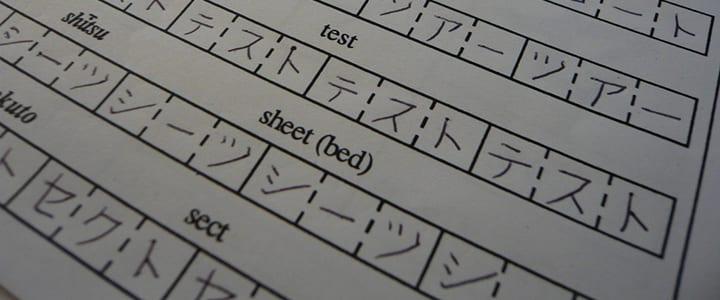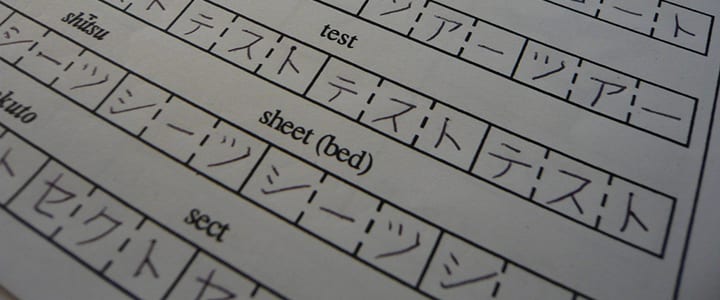When you’re learning Japanese katakana, it’s easy to be confused by so many new symbols. Here, Winston Salem, NC teacher Willy M. shares his tips and tricks to help you learn katakana.
While learning Japanese can be challenging, I have found an easy way to learn and memorize katakana. I want to share these methods with you, and I hope they will help you to quickly learn and understand Japanese katakana.
When I first started studying Japanese, I found it difficult to learn the symbols in the writing system. That is, until I learned this little trick. Simple tricks can make memorization much easier. This is true for Japanese, other languages, shopping lists, and just about anything else you want to memorize. I’m going to share two techniques that I think will help you learn Japanese katakana.
Basic Katakana
Japanese katakana consists of 48 characters. When you start to learn katakana, you will be shown a grid with the vowels on the top and the consonants on the side. The consonant combines with the vowel to form the sound of the symbol. So if you see the “K” on one side and the “A” across the top, the syllable is “ka.” This part of learning the syllabary isn’t too difficult, but learning to distinguish between symbols can be challenging for beginners.
Word Associations
The first technique that I used when I was learning the katakana syllabary was to associate images with the symbols for each syllable.
Here are some examples:
The first line of combined symbols for the katakana are “ka,” “ki,” “ku,” “ke,” and “ko.” I try to associate the Japanese symbol “ka,” with an image in my head of something that starts with the letters “ka,” or “ca,” in English. For me, I thought of California. On a United States map, California is a long shape with a slight curve. I will admit California has an inward curve and the symbol for “ka” has an outward curve, but in my mind, a curve is a curve, and it served the purpose to help me remember. Use this method and pick objects that work for you.
The next syllable, “ki”” sounds like “key” in English. I imagined drawing a little circle at the bottom of the “ki,” symbol to form a key.
I’ll give you one more. To me, “ku,” sounds like “coo,” the sound that a dove would make. I imagined the curving part of the symbol for “ku” as a dove’s chest, and it helped me remember that symbol.
Flashcards
When I realized that these associations helped me memorize the symbols, I took it a step further. I took an index card and drew the Japanese symbol in bright red ink in the center of the card. On the back of the card, I wrote the sound it makes in English, and any of the associations that I had developed from the previous exercise.
Then, on the front of the card, I drew an image around the big red symbol. I did this for each symbol, and I had a set of flashcards that I could use to remember katakana!
This takes a lot of time and effort, but it’s also a lot of fun. If you take the time to do this, you will learn and remember Japanese katakana. I would suggest getting a few of your friends or classmates to help you, not only will it speed up the process, but it will be a lot more fun!
Share this Image On Your Site
I hope these tips make it easier for you to learn Japanese katakana. For more study tips and one-one-one instruction, find a Japanese tutor near you.

Willy M. teaches guitar, ukulele, and mandolin lessons in Winston, NC. He studied Japanese at Earlham college in the ’90s, which at the time, was one of the top five schools in the world for Japanese studies. He took Akido and Karate lessons while studying the Japanese language. Learn more about Willy here.
Maile Proctor



